If you’ve played almost any amount of videogames in the past decade or so, you are no doubt familiar with “Souls” games, FromSoftware’s hack-n-slash action RPG franchise that has spanned multiple titles and game systems. The franchise really started with 2009s Demon Souls, but they’ve continuing honing the gameplay style across a number of different games including the most recent and very popular Elden Ring.
To the excitement of many, Steamforged Games launched a Kickstarted campaign for a tabletop board game in 2016 and famously secured their funding in three minutes of launch. The board game has been met with pretty universal praise, provided that you and your friends are up for a very challenging and occasionally frustrating time learning fight mechanics and dying repeatedly. If you expected anything else from a Dark Souls game, we’re not sure what to tell you here.
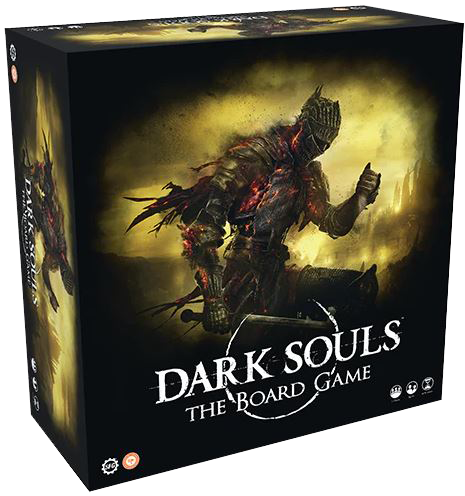
The game and its expansions offer a wide variety of heroes, enemies, and bosses, each of which come either completely assembled/based or minimal assembly snap-ins. While the grey plastics of the models are completely playable from the jump, Dark Souls: The Board Game does offer owners a nice optional hobby challenge.
For those interested in collecting miniatures just for the sake of hobbying, or for the recently released Dark Souls RPG (check out our review!), Steamforged has released a line of Dark Souls models in individual packs. Many of these models are available in the board game, but some are unique to the RPG line!
In this article we’re going to take a look at the model design, materials, and painting methods for getting your heroes and villains ready to die in full color.
The Models
Something that’s going to jump out at you comparing the Dark Souls core game or expansion boxes: the packaging is surprisingly high quality. The box, plastic slips, and cardstock are all substantial and definitely give you the feeling you’re picking up a premium product. Each model is individually enclosed in plastic to avoid damage and comes with its own rules. This is not the first or last miniature product to give you a good presentation, but compared to some of the other modern sets available it is noticeable and somewhat refreshing.
Here’s an example of what a set looks like:
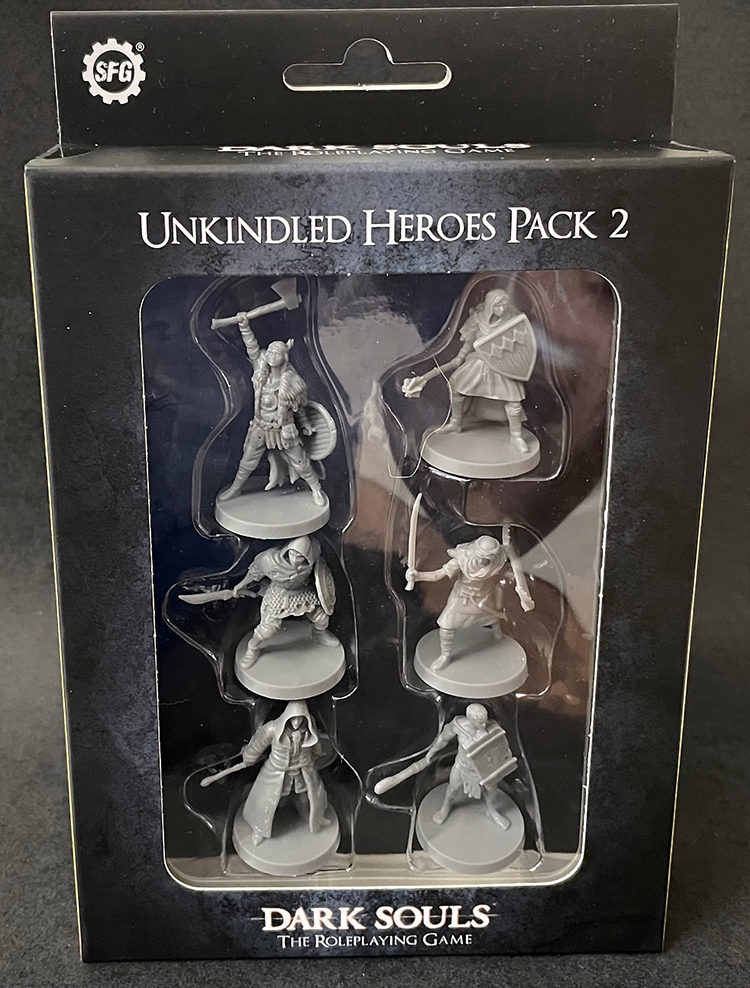
As you’ll see from the images, each model is permanently positioned in a dynamic pose. For the player, the individual hero models all look great. Each one has good character and feels like they’re contributing a unique role to the game. Non-boss enemy models, however, all have the same pose. If you’re just painting/fighting one, that’s fine, but multiples looking exactly the same feels like missed opportunity. Sets that sell four of the same model type, such as Silver Knight Greatbowmen, could really use at least a second variant. It’s not a deal-breaker, but it’s not ideal.
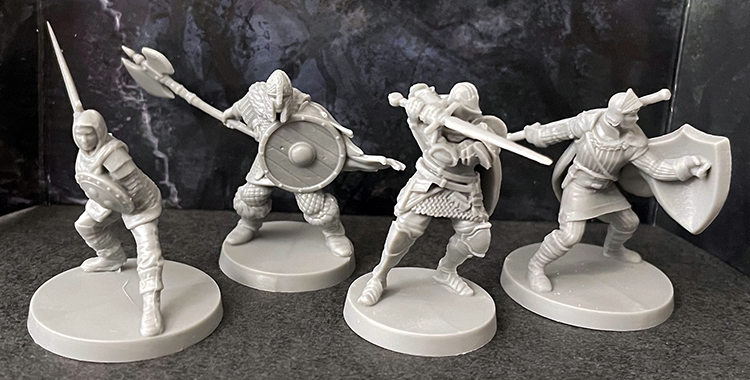
In terms of model details, this is where the some of the models slip a bit. Either by nature of their casting process or the material formula they used, model have slightly blunted details where its obvious that should have been sharper. Some chain mail and textured patterns disappear in a smudge, some surfaces are just flat, some swords and other pointed bits round out too much. Given that the models are working in an indeterminate 25-32mm scale, it’s not unheard of for this to happen, but it can be a little disappointing because the lack of texture makes painting more difficult. The material is also less-than firm, so some of the weapons and protruding pieces may need to be gently bent back into position prior to starting your work.
Most of the hero models involved are helmeted, but those that aren’t are not exactly going to wow you with face detail. The size of the area isn’t large enough to provide many design options and will leave you with some general shapes/surfaces, but the character is going to be the sum of the model and not any particularly heroic visage.
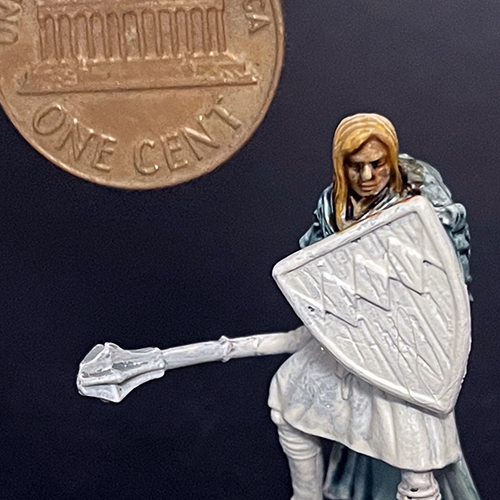
To prepare for painting the models, it’s always a good idea to look them over for flashing. Having looked over a good many of them, Steamforged has done a great job with quality control in this regard. Few if any have egregious lines and those are do are relatively simple to clean off in advance.
Painting Techniques and Examples
Let’s discuss how we want to approach painting the miniatures. For both varieties, the intent here is to provide a “tabletop quality” presentation for a relative beginner more interested in the board game than perfectly detailed minis. In the interest of showing off how the models look straight out of the box, no mold lines/flashing were removed in the examples. Beyond what examples we offer, there’s plenty of opportunity to dig in a little deeper if you’re interested.
While there’s a multitude of paint brands, all the colors used below are Citadel paints.
Traditional base/shade method
Likely the most common painting practice for hobbying: prime, base coat, shade, highlight. This is a relatively quick and simple style that works well with smaller miniatures, where you can pick out a few details after the shade sets in. This is the style we’re going to present here.
The first example is the Knight from the core game (also sold in the Unkindled Heroes Pack 1 set), photographed in three different stages:
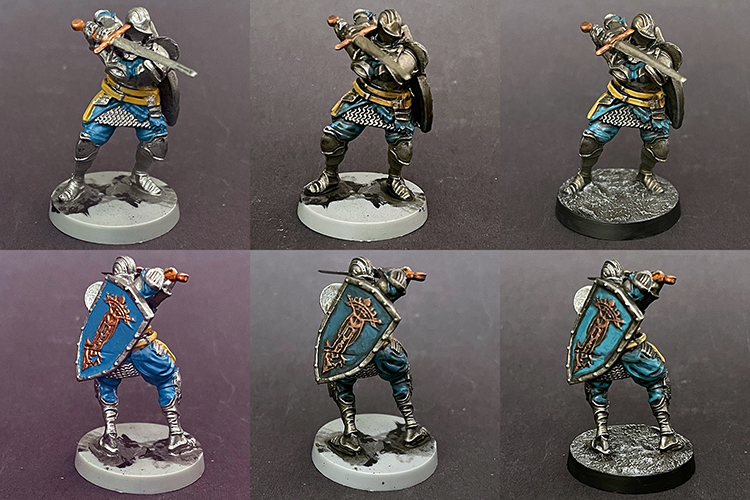
This model was primered in Chaos Black, the metal basecoated Leadbelcher and cloth/front of the field painted in a teal-blend of Caledor Sky and Warpstone Glow. The pommel and shield emblem are painted Balthasar Gold, the straps are Balor Brown, and the grip has a touch of Skrag Brown. Next, the entire model was given a liberal application of Agrax Earthshade–this applies a nice dark earthen tone for everything. Finally, each bit was touched-up with its original color, followed by as edge-highlight with Ironbreaker on the metals and a mix of Balor Brown and Ushabti Bone for the straps.
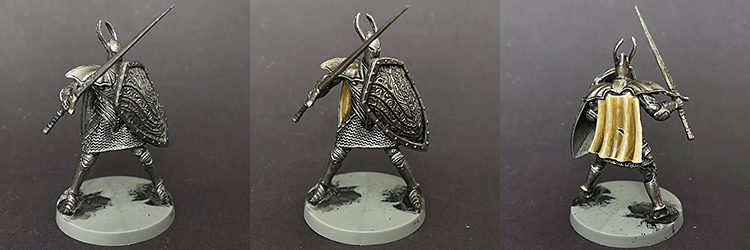
Unsurprisingly, the Silver Knights are very simple and primarily just a metal and wash. The entire thing was based in Leadbelcher, except for the cape which was based in Balor Brown. Additional layers of Balor Brown and Ushabti Bone was applied, raising the lighter colors each time until you get a satisfactory look. All non-cloak parts of the model were then shaded with Agrax Earthshade, then highlighted with Leadbelcher. The cloak was very gently shaded to avoid pooling, then given a final highlight around the edges with Wraithbone.
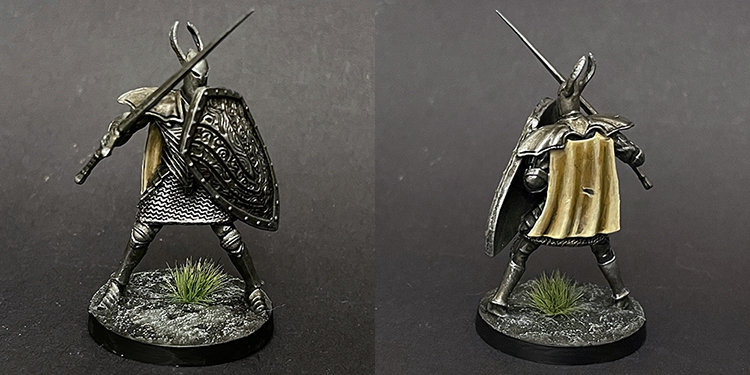
Shading Method
A more modern technique, painting using shades with high-pigmentation and specialized flow is very popular and for good reason. Once the models are primed white, they can quickly come to life with a simple application of a few paints you just slap on and wait to dry.
Here is an example on a Hollow Crossbowmen model:

This model was primered with Wraithbone, followed by a coat of Coelia Greenshade constrast for the clothes and Plaguebearer Flesh contrast for the skin. The crossbow stock was based in Skrag Brown, the shoes in Balor Brown, and the metallics (chainmail, helmet, arrow/bow limb) in Leadbelcher. A bit of watered-bown Fire Dragon Orange was used on parts of the metals to give a rusted look. Next, the entire thing was covered in a coat of Agrax Earthshade. Finally, small portions of the model were touched up with their original colors, as well as adding some edge highlights to the bow, helmet, and shoes.

Boss Models
If there’s one thing the Souls series is known for, it’s gigantic grinding battles with absolutely huge monsters. The board game does not disappoint in this regard. Larger boss models are going to require some assembly, as shipping them as modelled would consume too much space. Models are quick-assembly sockets, though experienced hobbyists may want to take a few models to shave down and properly fit things. This Guardian Dragon, for instance, came with a few large gaps between the segments (which I have left modelled here to give you an idea).
Something you’ll note in the game mechanics and the boss model bases: models have facings marked on their base with divider lines. In this Guardian Dragon example, I decided to mostly model over these, but have marked the divider appropriately on the base rim.
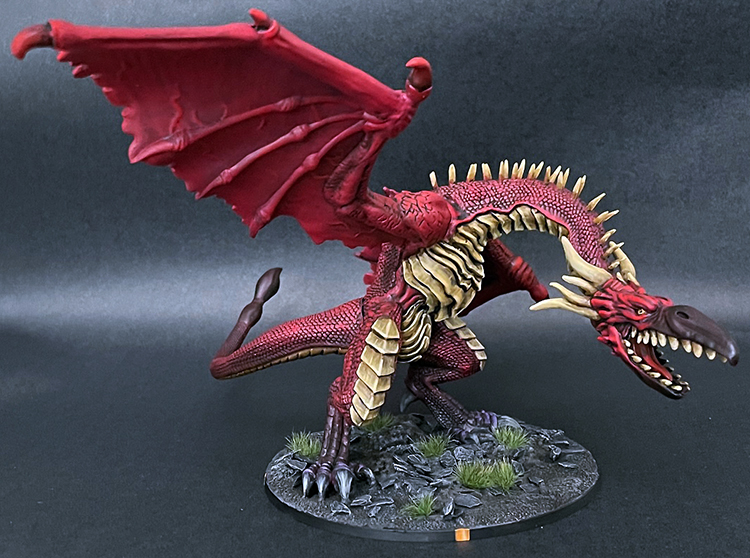
This model was primered using Chaos Black, the scales/skill were base coated in a 75/25 mix of Wazdakka Red and Genestealer Purple, while the horns/teeth/armor plates were based in Balor Brown. Next, I took a few passes of watered-down Chaos Black/Genestealer Purple at the beak, feet, and tail spike to give it a transition to darker violet at the ends. As with everything, the next step was shade the model with Agrax Earthshade.
Next, the base surfaces were touched up with their original colors, then highlighted. The skin/scales were highlighted with Evil Sunz Scarlet. The horns/teeth/armor plates were raised with a mix of Balor Brown and Ushabti Bone, followed by Ushabti Bone itself, then a final highlight of UB and Wraithbone. The talons are a 50/50 mix of Chaos Black and Wraithbone, followed by some streak highlights of 25/75 CB/WB. The eye was a coat of Averland Sunset, followed by a dot of Chaos Black, and a final very tiny and careful dot of Wraithbone toward the top left of the iris.
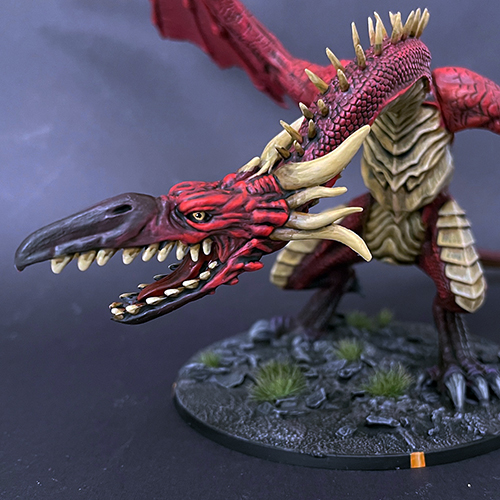
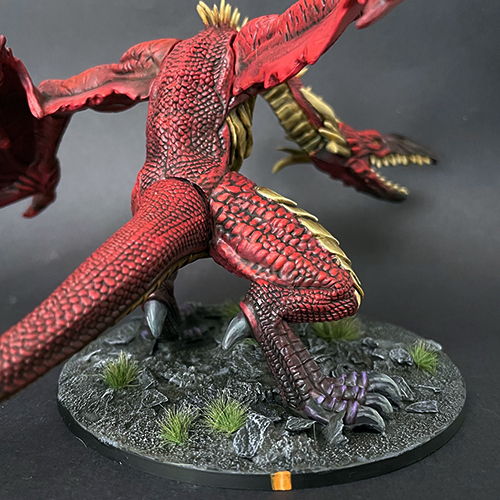
As you can see, while the model is definitely tabletop-ready, but there’s still a lot of detail that might be lifted with additional effort. Additionally there are a few spots that are lacking in textured detail–such as the shoulder joints, some of the scales, and the wing membranes–and call out for some additional painting to add in artificial texture. For a large-scale model, the Dark Souls boss monsters are still a relatively quick and enjoyable project.
Wrap Up
If you’re a board game player looking to venture into the world of Dark Souls, looking to use the model kits for other tabletop adventures, or just want some fun projects to work on, you could definitely do worse than the Dark Souls miniatures provided by Steamforged Games. They’re not extremely detailed, but they’re quick to paint up and they have a great dungeon-crawling style.
Have any questions or feedback? Drop us a note in the comments below or email us at contact@goonhammer.com or, if you’re a patron, head on over to our Discord and chat with us!
A big thanks to Steamforged Games for providing the models for this review.


